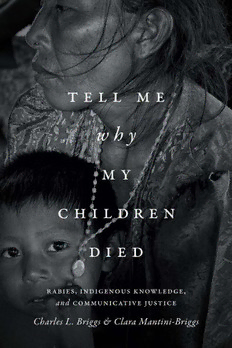
Tell Me Why My Children Died: Rabies, Indigenous Knowledge, and Communicative Justice PDF
Preview Tell Me Why My Children Died: Rabies, Indigenous Knowledge, and Communicative Justice
T e l l M e w h y M y C h i l d r e n D i e d Critical Global Health Evidence, Efficacy, Ethnography Edited by Vincanne Adams and João Biehl T e l l M e w h y M y C h i l d r e n D i e d Rabies, Indigenous Knowledge, and Communicative Justice Charles L. Briggs & Clara Mantini- Briggs Duke University Press Durham and London 2016 © 2016 Duke University Press All rights reserved Printed in the United States of Amer i ca on acid- free paper ∞ Designed by Courtney Leigh Baker Typeset in Garamond Premier Pro by Westchester Publishing Services Library of Congress Cataloging- in- Publication Data Names: Briggs, Charles L., [date] author. | Mantini- Briggs, Clara, [date] author. Title: Tell me why my children died : rabies, indigenous knowledge, and communicative justice / Charles L. Briggs and Clara Mantini- Briggs. Other titles: Critical global health. Description: Durham : Duke University Press, 2016. | Series: Critical global health: evidence, efficacy, ethnography | Includes bibliographical references and index. Identifiers: lccn 2015038469 isbn 9780822361053 (hardcover : alk. paper) isbn 9780822361244 (pbk. : alk. paper) isbn 9780822374398 (e- book) Subjects: lcsh: Warao children— Diseases— Venezuela— Delta Amacuro— History—21st century. | Epidemics— Venezuela— Delta Amacuro— History—21st century. | Discrimination in medical care— Venezuela— Delta Amacuro— History—21st century. | Communicable diseases in children— Venezuela—D elta Amacuro— History—21st century. Classification: lcc ra650.55.v42 d458 2016 | ddc 362.196900987/62— dc23 lc rec ord available at http:// lccn . loc . gov / 2015038469 Cover art: Anita Rivas watches her husband’s lament, Barranquitas, Venezuela, 2008. Photo graph by Charles L. Briggs. For Elbia and Mamerto and the others who died in the mysterious epidemic For Librado and for Feliciana, Bill, and Nancy and for Guerino, Estrella, and Alfredo This page intentionally left blank c o n t e n t s Illustrations ix Prologue xiii Preface xvii Introduction 1 I 1 Reliving the Epidemic: Parents’ Perspectives 29 2 When Caregivers Fail: Doctors, Nurses, and Healers Facing an Intractable Disease 76 3 Explaining the Inexplicable in Mukoboina: Epidemiologists, Documents, and the Dialogue That Failed 109 4 Heroes, Bureaucrats, and Ancient Wisdom: Journalists Cover an Epidemic Conflict 127 II 5 Narratives, Communicative Monopolies, and Acute Health Inequities 159 6 Knowledge Production and Circulation 179 7 Laments, Psychoanalysis, and the Work of Mourning 205 8 Biomediatization: Health/Communicative Inequities and Health News 225 9 Toward Health/Communicative Equities and Justice 245 Conclusion 260 Acknowle dgments 275 Notes 279 References 287 Index 303 This page intentionally left blank i l lu s t r at i o n s maps P.1 Delta Amacuro State xviii I.1 Area where cases were concentrated 11 figures P.1 Inez Rivero with her baby daugh ter, 2008 xiv P.2 The team in Enrique Moraleda’s balajú, Misluoy I, 2012 xx I.1 Houses in Mukoboina, 2010 12 I.2 Clara, Enrique, Conrado, and Eumar planning the team’s investigation, 2008 14 1.1 The Baeza family garden in Mukoboina, 2010 30 1.2 Wilmer Torres, 2008 33 1.3 Graciano Florín, 2008 35 1.4 The national identity card for Ángel Gabriel Florín 35 1.5 Santa Morales with her youn gest daugh ter, Yamileta, 2010 38 1.6 Alfonso Torres, 2010 39 1.7 Romer Torres, 2008 41 1.8 Odilia Torres with her daugh ter, Yuneli, 2008 42 1.9 Muaina, 2008 46 1.10 Elders gathered for the meeting in Muaina, 2008 48 1.11 Enrique speaks as the meeting begins, 2008 50 1.12 Florencia Macotera and Indalesio Pizarro, 2010 51 1.13 Florencia Macotera narrates Dalvi’s death in the Muaina meeting, 2008 52
